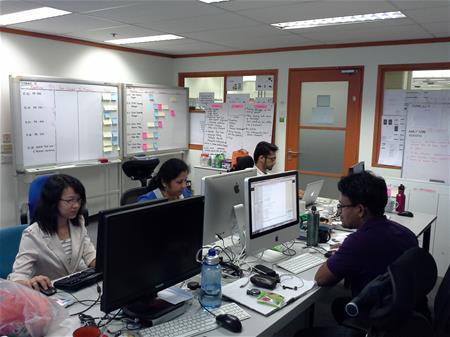Do the pay-offs in ‘Agile’ methodologies outweigh the initial challenges? NUS-ISS evangelist Gloria Ng draws on her experience at Philips Singapore, where she supervised an internship which the students were scrum team members, to bring us these insights.
Most organisations shy away from change management, especially when it comes to well-established processes. At Philips Singapore however, a requirement to nurture a new competency in managing entertainment systems using mobile devices provided the perfect opportunity to embark on a Scrum journey.
As a framework that encourages project teams to be more self-organised, the Scrum methodology engenders greater task ownership while providing a dynamic process for the delivery of accurate and quality solutions.
Getting the team initiated and accustomed to the rigours of Scrum was one of the first priorities for the pilot project at Philips. This entailed a series of trials and training programmes for the pioneering team, and the certification of Philips’ first Scrum Master. While careful to preserve the core values of Scrum, the team kept an open mind towards building flexibility into their adoption approach.

The scrum room at Philips Singapore
Managing initial roadblocks
Scrum was operationalised from members’ cubicles at first, before a “lightweight version” of the elements essential to the Scrum practice could be established. Physical adjustments, such as assigning a dedicated Scrum Room for communication with local and remote stakeholders, triggered significant shifts in mindsets and behaviours amongst team members.
During planning sessions, the team would determine their task commitments for each Sprint cycle by prioritising the stories from the Product Owner. It was initially observed that team members would begin with tasks they were most comfortable with. The Scrum Master played a crucial role to mitigate delays by realigning the team’s focus on the high priority stories. The team also learned to dissect their stories more carefully in subsequent Sprint cycles, bearing in the mind the inter-dependencies of one another’s tasks and processes.
Taking on the design responsibility and working out the supporting steps involved was a huge shift from the traditional approach to application development. As the Scrum Master puts it, “it took a while for members to warm up to this empowerment, but now, there’s no need to monitor them!”
Practice makes perfect
One of the key concerns of Scrum adoption in an organisation like Philips had to do with the major dependencies that exist between its hardware, firmware and software development. Managing the Product Backlog to identify these dependencies, and working out the priorities and time frame for addressing these dependencies were important considerations.
It would take about three to five Sprint cycles before the team could reach a steady state where obligations and task definitions became more precise. There was a natural sense of urgency due to the time constraints of each Sprint cycle, and the team learned quickly to work closely with the Product Owner, and with each other, in order to realise their goals expediently.
Not surprisingly, the improvements became more evident with greater assimilation. For example, when stories lacked clarity, conscious efforts were made to break them down further. To speed up each process, a design “architect” was appointed to review the story points and to estimate the man-days involved to meet a required objective. Paired programming was also used to control the quality of what was being developed, while checklists were created to promote a test-driven design environment.
Incorporating fresh insights
Learning had been a two-way street with this pilot Scrum initiative, as our interns from the Graduate Diploma in Systems Analysis programme were able to bring new perspectives on the discipline of System Architecture. It contributed to the Scrum buy-in from the other supporting business divisions, and has paved the way to Scrum adoption for other projects at Philips.
Today, as agile practices like Scrum set the stage for software development, fortnightly Scrum Master Forums are organised to facilitate discussion across project teams, and to share information as software and business requirements evolve.
The Scrum approach encourages projects team to establish a common bond, which leads to more collaborative behaviours, less anxiety and trust. For Philips Singapore, key benefits have included a more flexible work approach to the software development process, higher productivity, and greater focus on quality – and in the competitive world of electronics, a framework that encourages more ownership and less management can make all the difference.